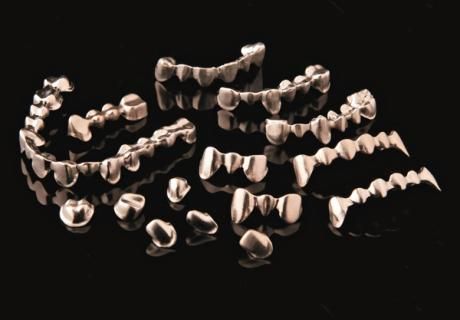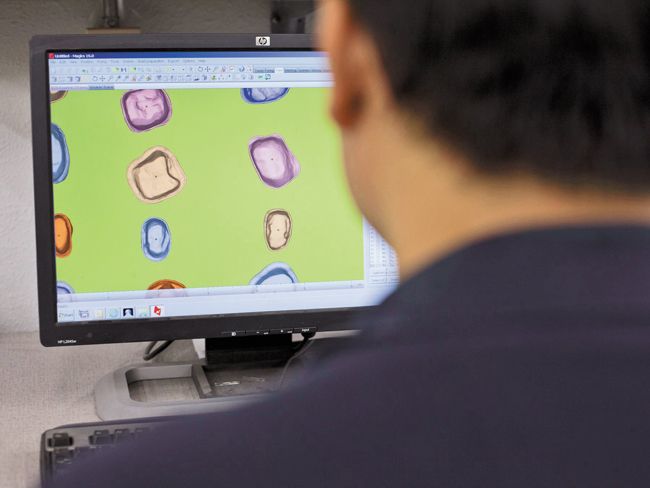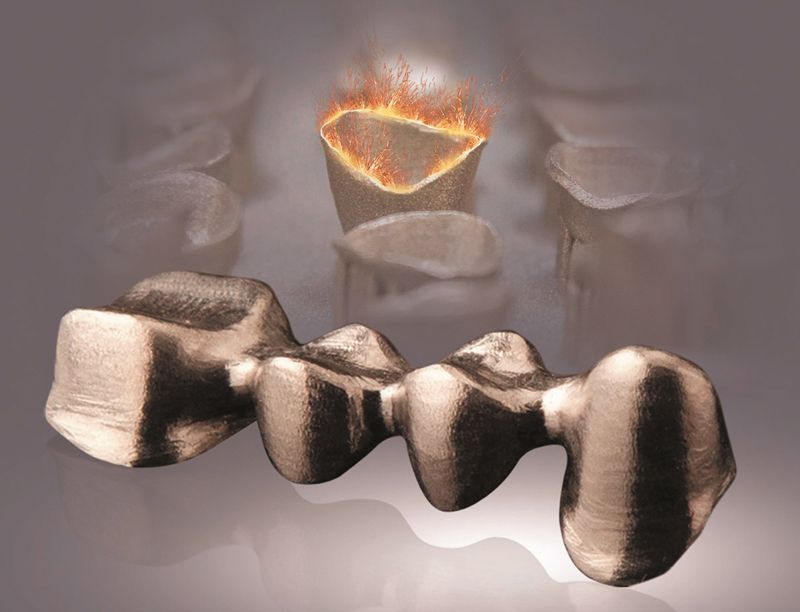How Argen can help you with noble metals - without casting
“I tell them it can broaden their offerings, eliminate inventory, cut waste and significantly boost their productivity,” he says. Those advantages can be powerfully persuasive for the laboratories who are listening.
SLM technology is changing the noble metals game, and Argen Digital is leading the way. Here's how.

When Paul Cascone, senior vice president of research and development at Argen, speaks to a potential dental lab customer, he always leads with the benefits of digital technology.
“I tell them it can broaden their offerings, eliminate inventory, cut waste and significantly boost their productivity,” he says. Those advantages can be powerfully persuasive for the laboratories who are listening.
Related: How Argen Digital can help with implant work
For years, the manufacture of dental prostheses has been based on the lost-wax method, which has roots in 5,000-year-old investment casting techniques. In this approach, dentists rely on a molded impression of the damaged tooth (or teeth), a careful sequence of production steps and painstaking hand finishing-and remake levels tend to be high. But during the last decade, digital tools and technology have been cutting time and cost from workflows, enabling the dental lab business model to evolve towards greater efficiency and precision.
Digital dentistry practices
The transition to digital begins with the impression. Where a physical mold of a patient’s teeth serves as the starting point for a lost-wax casting, the digital equivalent is an image of the teeth taken in the mouth with an intraoral scanner (although scans can also be made from physical impressions). The resulting CAD (computer aided design) 3D model can be used to create a restoration in several ways.
One path is via a computer-controlled milling machine (CAD/CAM dentistry). In this subtractive manufacturing approach, the digital file of the model guides the cutting of either a solid ceramic or composite-resin block into a prosthesis matching the shape of the teeth. Another path is selective laser melting (SLM), a technology in which Argen is an industry leader. In this additive manufacturing (AM) process, which utilizes selective laser melting, the CAD model guides production that adds on layers of material, rather than cutting it off and throwing it away (as with milling). The automated sintering process starts with the system depositing a thin layer of metal powder onto a build platform. A laser, guided by the CAD model, then traces a cross-sectional outline of each patient-specific dental unit, melting and hardening the material into a 20-micron-thick layer. This cycle repeats, adding on layers one at a time, until the restoration is fully formed.
The benefits of AM technology for laboratory customers are many: Steps in the traditional workflow can be skipped; virtually any geometry can be created; waste is reduced; the resulting restorations are accurate and as durable as those made with lost-wax casting; and, while fine detail can be captured in both the subtractive and additive processes up to certain limits, there is no added cost with AM for sculpting more complex tooth geometries.
What it means that Argen now offers high-noble SLM
“When a lab customer is interested in switching to a digital process, of all the production tools we can offer them we always recommend that they take advantage of our selective laser melting capabilities,” says Cascone.
Next page: What does SLM offer?
Going with the SLM flow
“We were one of the first U.S. companies in the dental industry to use SLM technology,” Cascone says. That was in 2007, and the system Argen purchased, after considering other AM processes, was an EOSINT M 270 from EOS. Up until that time, according to Cascone, digital STL files were only being used to mill all-ceramic restorations. “We wanted to use the available CAD data to meet the need for strong, precise-fitting porcelain-on-metal restorations,” he notes. “Our new SLM system gave us the flexibility to manufacture the metal base.”
The List: 5 things you need to know about metals
In the U.S., several types of metals-nobles, high nobles and base alloys-are used widely by dental labs and dentists. While base materials predominate, Argen wanted to offer digitally produced precious-metal products to the domestic market. So, they decided to develop their own noble alloy (containing 25 percent palladium) suitable for laser sintering. Of importance in their research efforts were characteristics such as biocompatibility, porcelain compatibility, thermal properties, mechanical strength and corrosion/tarnish resistance. Thousands of possible metal combinations were evaluated, followed by field testing of the best candidates. The result: Argen is now a leader in SLM Noble substructures.

Digitally designing substructures
With a first success in hand, the company decided to undertake another development project to meet the marketplace’s broad spectrum of needs. This effort involved an even more durable high-noble alloy (made with 40 percent gold and at least 20 percent of another precious metal such as platinum or palladium). “It was challenging, but we were successful,” Cascone notes. “We invest heavily in R&D with a focus on increasing the variety of porcelain-on-metal units for lab customers who want to go digital.
“Now we offer nobles, high nobles and base alloys in the digital workflow, and we can make bridges of different sizes from all three classes of metals. What’s next for R&D is a high palladium noble alloy plus SLM Captek, the unique composite made from a gold-platinum-palladium alloy combined with almost pure gold, which gives the restoration both great esthetics and high strength. We’re also gearing up to produce partial dentures.”
Popular on DLP: 10 of the CRAZIEST impressions you've ever seen
The SLM system’s software also automatically labels each patient’s unit and generates supports on the models prior to manufacturing. These hollow supports allow for easy removal from the build plate once the run is complete and, during finishing, they are eliminated along with excess material from each restoration. The unit is then shipped to the lab customer for bonding with ceramic. “The additive manufacturing operation is straightforward and quite robust,” says Cascone. “Quality is high, tolerances are constant and the process is reproducible. Our lab customers are impressed, not only with the savings in time, but also with the consistency and accuracy of the product.”
Next page: How any lab can benefit from a digital mindset ...
Catching the digital current
Currently, SLM systems are gaining popularity for dental applications, and in some countries this technology has almost completely replaced casting. In the U.S., dentists are increasingly requesting products that force labs to get involved with digital workflows, Cascone explains. But those labs still have a choice about how fast and fully to embrace digitalization.
Must read: 10 Implant trends you need to know
If they are thinking about all-ceramic units, they can either invest in a scanner and milling machine, or they can just purchase the scanner and outsource the rest. “Lab size and work volume may dictate their decision,” says Cascone, “but we advise them to at least purchase a scanner and get started.”
If the goal is porcelain-on-metal restorations, there is a different set of considerations. “In the past, we provided the alloy for our customers to cast into restorations,” Cascone says. “Now with our selective laser melting services, we supply copings and frameworks to the customer 95 percent finished. They can now concentrate on the important esthetic and functional aspects of applying the ceramic. This represents a change in their business model, but they’re really excited about the change.”

For the dental laboratory, taking the digital path can be a game changer, according to Cascone. In a small lab, a scanner can help them expand their product offering. In a large production lab, the whole scale of the operation can be transformed. “A skilled technician using traditional hand operations can make about 20 units in a day,” he explains. “If you take that same person and train them to use a scanner and software, output accelerates to 80 units a day. That’s why labs are switching.”
Important: The latest salary data for dental lab technicians
After hearing about the digital workflow, how long does it take a laboratory to decide to switch? “If it’s a lab that doesn’t have a scanner, then typically there’s a little more conversation,” Cascone says. “If it’s a lab that already has one, they’re usually ready to send us the digital data immediately.”
Product Bites – January 19, 2024
January 19th 2024Product Bites makes sure you don't miss the next innovation for your practice. This week's Product Bites podcast features new launches from Adravision, Formlabs, Owandy Radiology, Henry Schein Orthodontics, Dental Creations, and Dental Blue Box. [5 Minutes]
Product Bites – December 22, 2023
December 22nd 2023The weekly new products podcast from Dental Products Report is back. With a quick look at all of the newest dental product launches, Product Bites makes sure you don't miss the next innovation for your practice. This week's Product Bites podcast features updated software from Medit. [2 Minutes]